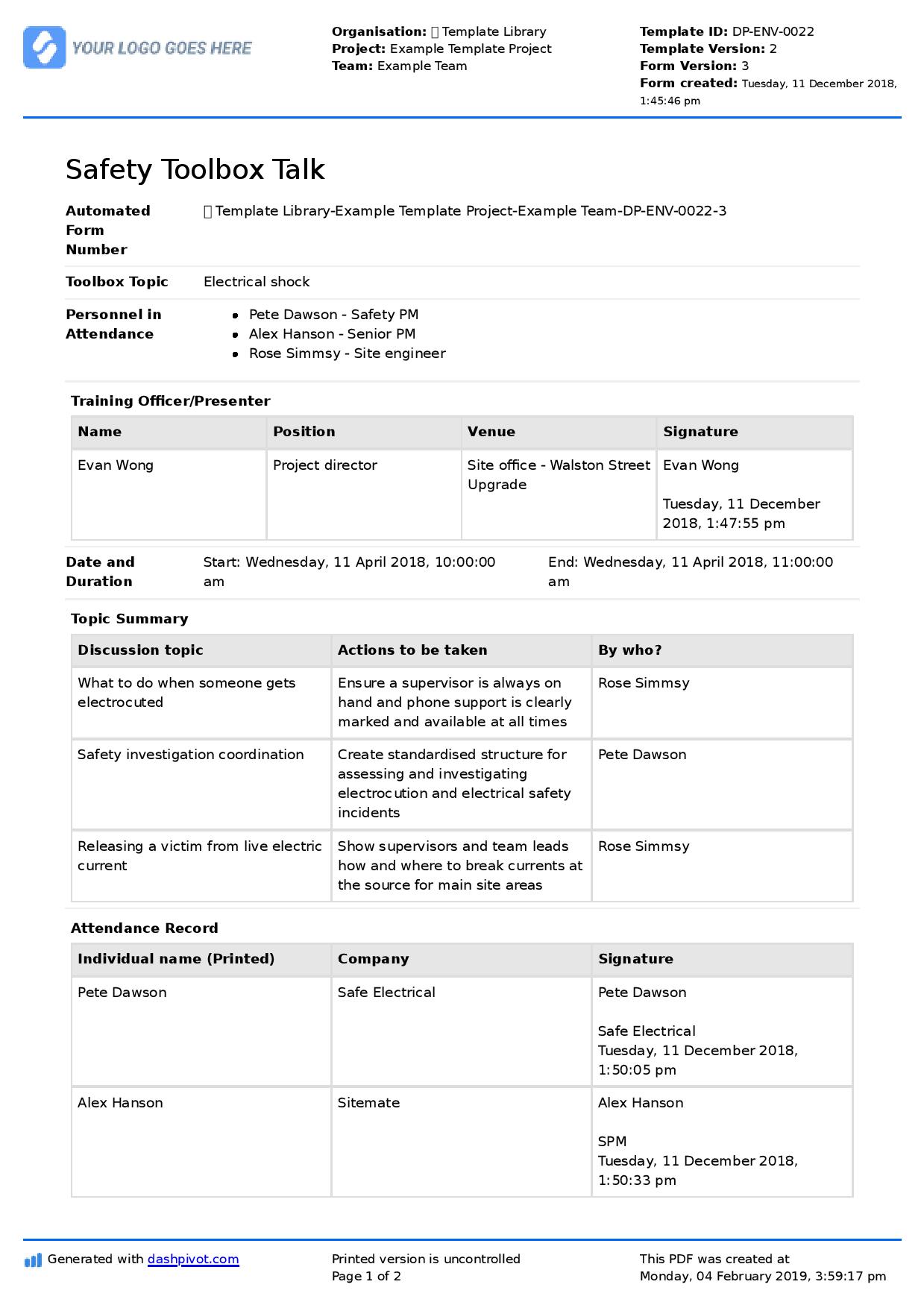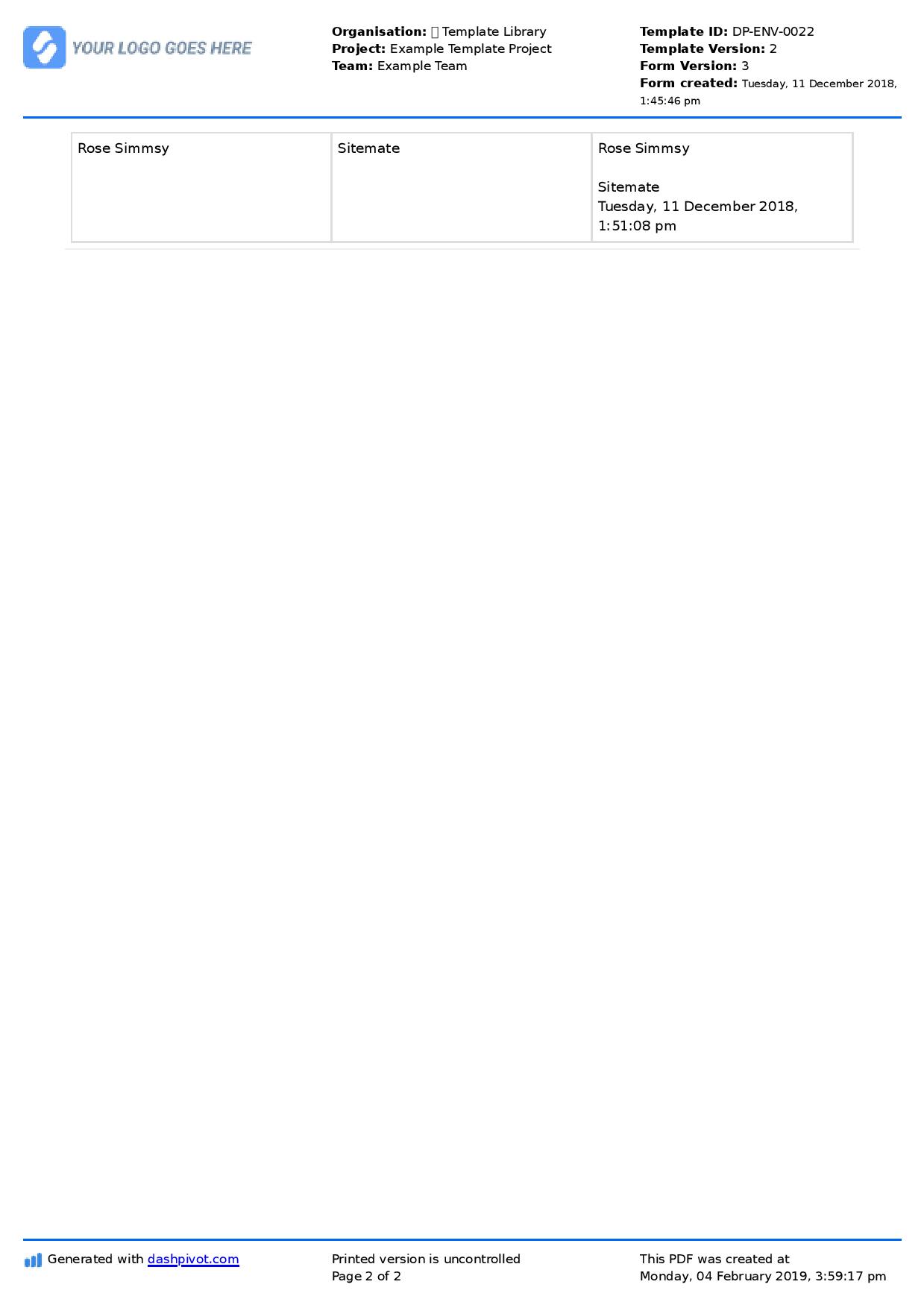Dashpivot article – Why are toolbox talks important
Why are toolbox talks important?
How this post will help you is two-fold, to answer the question of why are toolbox talks important in general, as well as to provide you with some usable resources for improving your toolbox talk sessions, records and compliance.

Why do we have to do toolbox talks?
Toolbox talks are common in the many industries in the built world and if you ended up having to search for the meaning and importance of toolbox talks, chances are you don’t appreciate it as much as it was intended to be, or you wanted to pinpoint a good reason for your team to appreciate this. There are countless ways to answer the question why are toolbox talks important - which we'll explore in this article.
The intention behind toolbox talk is to put a spotlight on the importance of safety in the work that you do in the workplace as frequent as possible. Why? Because people tend to forget especially when they’re already familiar with their work and it’s always beneficial to talk to the people directly involved if there are safety concerns and issues that come up.
Did you know that there’s barely any safety regulatory body that requires companies to do toolbox talk? Yes, it’s not for compliance it’s an innovative initiative of the company to have a better communication regarding safety in the workplace. The Occupational Safety and Health (OSHA) does not explicitly require toolbox talks, HSE (Health and Safety Executive) does not legally require toolbox talks as well however it is recommended, and in most countries, while training your workers and informing them about safety in the workplace is compulsory, toolbox talks is not mandated to be the way to do it–but why it is it that more and more companies are performing toolbox talks every working day before the shift starts?
Why are Toolbox Talks Important?
As mentioned, in the different government safety regulation bodies like OSHA in the US and HSE in the UK, Toolbox Talks are not mandated but it’s a highly recommended safety practice to prevent workplace injuries and engage workers to be more concerned about the policies implemented to protect them. You can read more about the relationship between OSHA and toolbox talks here.
Here are some of the core reasons why toolbox talks are essential and important:
Why do we have Toolbox Talks #1 - To Engage Your Workers
Toolbox talks encourage two-way communication at work on workplace safety. Safety trainings in the workplace are regularly done annually and during intake of new workers and it’s important because it gets everyone to be educated on what hazards they are exposed to and what are the safety policies in place but because it usually only occurs a few times in a year and lasts a few hours in a day it doesn’t really have the time and space to get the workers engage and learn what they think plus in reality others might skip these trainings.
When toolbox talks are done right, it gives a time for the team to raise points of information or query about the talk on construction safety for example. It will give the management pointers on what to improve because an actual worker raised it and because toolbox talks are a close yet informal set-up the presenter will have the opportunity to see their reactions about safety topics rather than sit hundreds of people in a formal safety training and make them watch a bunch of videos about safety, you will be able to see them engage.
Toolbox Talks will make incident prevention easier
Typically, when an incident happens one of the solutions from the company’s safety team is to give a refresher training to the workers on what happen, why did it happen and what did the victim violate, and some might find it difficult to sit down to. Since toolbox talks are open discussions, it will give an opportunity for the team to feedback on what they learned from what happen and gets the leader to ask what did they miss on the safety reminder, was there no safety sign and was the safety protocol difficult to follow? Like, for instance did they not know that water fire extinguishers are not supposed to be used on electrical fire? Why did no one replace the dimmed light bulb? These talks actively address the safety concern based on the recent incident and makes the safety reminder more focused.
Toolbox Talks prepares the workers for the day
Since Toolbox Talks are regularly done in the beginning of the day before work starts. It gets them pumped up and ready to do their work. It keeps them reminded on the safety topics; it emphasises the importance of what they do even if it’s just a housekeeping chore at work that must be done to prevent incidents. It prepares them for their tasks mentally, helps them remember on the hazards in the workplace and influences their disposition on safety. For example, you give them a toolbox talk on slips, trips and falls when winter is about to come, it’s relevant for the week but it also reminds them about the tendency to slip on slippery floors making them mentally prepare to go about the factory. What you get out of it in an engagement is a genuine worker points out that the boots need replacement or some floors need repair – these things might have been missed by the management but instantly you get an idea what to do to prepare and the worker also feels heard on their suggestions.
Improve your Toolbox Talks in Three (3) ways, Make Them Even More Important
If you’re a project manager or supervisor, you might already be aware on the importance of toolbox talks and skipped over this section to look for a way to improve it, not making it dragging and be more effective as the least we want to do to our team is make them feel that our safety practice is exhausting. Here are three effective ways to improve your toolbox talks:
Know the difference between Safety Training versus Toolbox Talks
One of the ways to improve your toolbox talks is understanding that it’s not a formal safety training where you just talk and talk about what is safety and what we should do to be safe. Safety trainings are great and it’s an opportunity to educate the workers on the safety measures, the risks involved, the personal protective equipment they must wear etc., and toolbox talks are also that but it’s more focused, specific, brief (lasting 10 to 15 minutes) and more importantly it asks the workers to talk as in it gives time for the workers to speak up about their concerns and you can answer them right away or plan to address it.
During toolbox talks: Ask open ended and specific questions
We recommend improving your questions to the team when running your toolbox talks. So, after you read or present your safety topic, rather than asking “do you have any questions?” which is usually answerable by yes/no, ask:
“How can we improve our current safety procedure in the workplace?” – this will allow them to think and review by themselves the usual safety procedures they have and get ideas from them.
“Which controls do we have that you find difficult to do your daily work?”, –in toolbox talks there usually is a list of hazards and then controls and these questions would be a good opportunity to make sure it’s not interfering in their daily work and be more inclined to bypass.
“Which PPEs do you find uncomfortable to wear?” – this is another example of a safety control that is easy to bypass because it interferes with their work and it’s also necessary that PPEs like safety goggles and boots that is use to protect their eyes or body would not disable them to perform as normal, the toolbox talks on this would be more engaging and results driven.
Use a digital version of your toolbox talks to demonstrate their importance
Enter a new era of safety meetings by making your toolbox talks digital. This is an effective way to save your time in writing down points, reduce paper scripts by using your mobile or your tablet when reading the talk points, enable you to keep track of the toolbox talks copies as manual files can be lost or misplaced and let’s face it, if you’re out there having a toolbox talk on housekeeping practices on the job and improving storage it wouldn’t be sincere if you’re still doing your toolbox talks manually in paper. It will also enable you to get back on a topic that was raised the past week when you’re updating the team on the company’s response to the feedback or suggestions and make it easy to share and collaborate to other teams or a higher management.
Digital toolbox talks also prove why toolbox talks are important, as they ensure they are stored and managed correctly from a safety compliance perspective.
Here's a safety toolbox talk document to get you started and excited in the upgrade we’re suggesting:

Use and customise this digital toolbox talk template for free
Make it easy for your team to conduct toolbox talks
What makes this toolbox talk special? This toolbox talk is already built and it comes with all the necessary sections: topics, the option to add notes, and an easy method to just scan the QR code of your team to conduct attendance, smooth right? If you want to tweak it, you are free to customise or create a new one using a drag-and-drop feature of the software and open it with the latest version you just updated. You also have the option to download this toolbox talk as a PDF if you need it or open your saved files directly from the software conveniently, this saves you a lot of time to look for data or records.
Finally, from the beginning of this article post we had two simple goals: (1) to convince you why toolbox talks are essential by giving you insightful reasons i.e. that it engages your workers, that it will help your incident prevention easier and lastly that it prepares the workers for the day and (2) by giving you strategies on how to effectively implement it because maybe it was not done right and those strategies were three ways: know the difference between safety training and toolbox talks, ask open ended and specific questions during toolbox talks and lastly which is probably the most helpful, use a digital version of your toolbox talks using a software that is perfect for this.

Working at Heights Permit template
Mitigate the risk of dangerous and potentially fatal falls - and make the permit approval process seamless.

Scaffold Inspection Checklist template
Conduct thorough and safe scaffold inspection checklists directly from site using this daily or weekly scaffold inspection template.

Confined Space Rescue Plan template
This confined space rescue plan template makes it easier to establish and adhere to confined space rescue plan checklists, requirements and procedures.
